Are you looking for a way to infuse your home with elegance, warmth, and a touch of history? Italian interior design style might be the perfect solution for you. Known for its luxurious and sophisticated nature, Italian design combines classic elements with modern sensibilities to create spaces that feel both timeless and contemporary. In this article, we’ll explore the origins of Italian interior design, delve into its key components, and provide tips for incorporating this stunning design style into your own home. So, let’s embark on a journey to the world of Italian design, shall we?

Table of Contents
History of Italian Interior Design
Italian design has a rich history that dates back to the Roman Empire. Throughout the centuries, Italy has been known for its exceptional craftsmanship, attention to detail, and artistic innovation. During the Renaissance period, Italian design flourished, with renowned artists like Leonardo da Vinci and Michelangelo revolutionizing the world of art and architecture.
In the 20th century, Italian design experienced another resurgence, as the country became a hub for innovative furniture and product design. Today, Italian interior design remains synonymous with luxury, elegance, and a keen sense of style (read more about Italian Interior design history here)
Key Elements of Italian Interior Design
To truly capture the essence of Italian design, it’s essential to understand its primary characteristics:
Architecture and Layout
Italian interior design often features spacious layouts, high ceilings, and large windows that allow for ample natural light. Many Italian homes also boast architectural details, such as intricate moldings, frescoes, and vaulted ceilings.
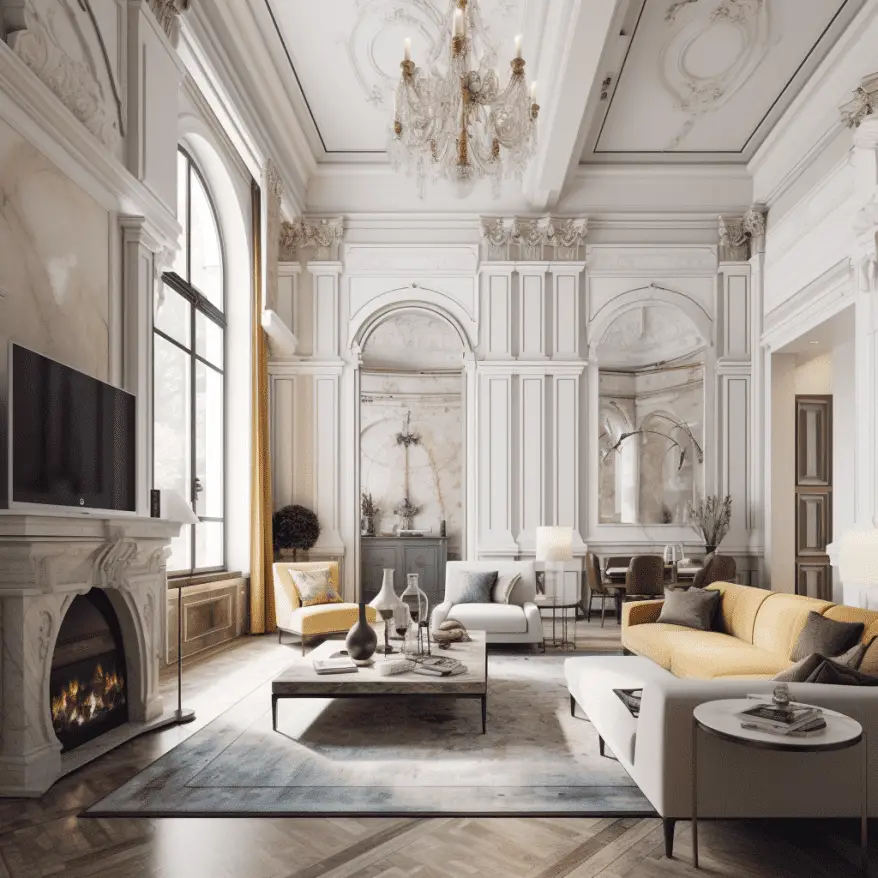
Rich Textures and Materials
Italian design is renowned for its use of luxurious materials like marble, wrought iron, and terracotta. Additionally, rich fabrics like silk, velvet, and brocade are commonly used in upholstery and window treatments, adding a sense of opulence and warmth to any space.

Classic Furniture
Italian furniture pieces are often characterized by their timeless designs and exceptional craftsmanship. From ornately carved wooden furniture to sleek, modern designs, Italian pieces are the perfect blend of form and function.

Color Palette
The Italian color palette typically incorporates earthy tones, such as terracotta, olive green, and deep reds. These warm hues are often contrasted with cooler colors like blues and grays, creating a balanced and inviting atmosphere.

Art and Accessories
No Italian interior would be complete without an array of art and accessories. Sculptures, paintings, and intricate tapestries are commonly displayed throughout Italian homes, adding visual interest and a touch of history to the space.
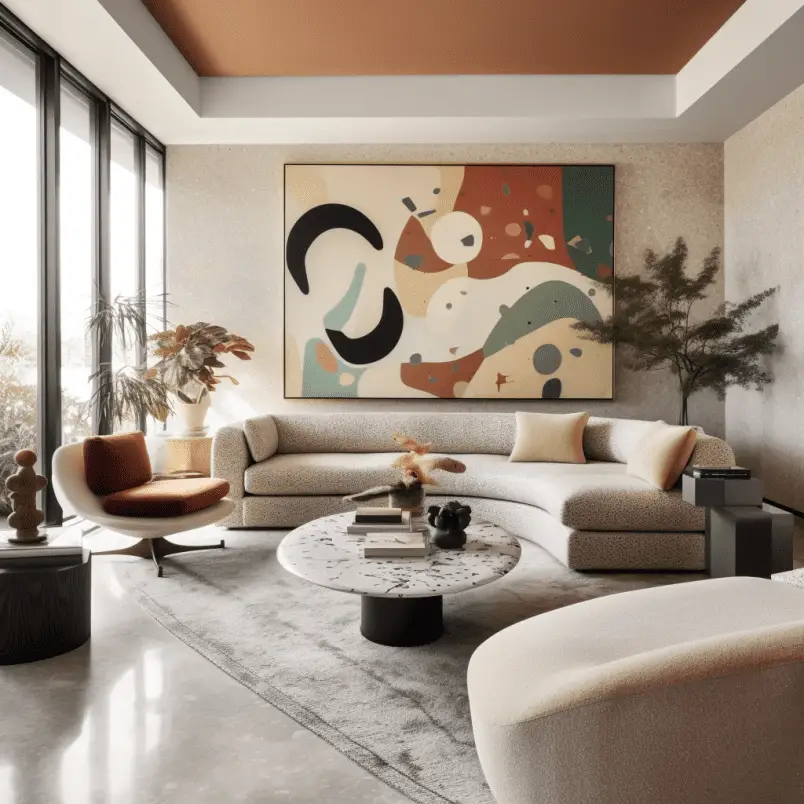
Incorporating Italian Design into Your Home
Ready to give your home an Italian makeover? Here are some tips to help you get started:
Focus on Architectural Details
If possible, incorporate architectural elements like arches, columns, or decorative moldings into your space. These details can add a sense of grandeur and history to any room.
Choose Luxurious Materials
Opt for high-quality materials like marble countertops, terracotta flooring, and wrought iron accents to infuse your home with Italian elegance.
Invest in Classic Furniture
Select timeless furniture pieces that showcase exceptional craftsmanship and design. Look for items with intricate carvings, curved lines, and luxurious fabrics.
Embrace Art and Accessories
Adorn your walls with Italian-inspired art, such as Renaissance paintings or frescoes. Additionally, incorporate sculptures, decorative ceramics, or antique mirrors to add visual interest and a touch of Italian charm.
Create a Warm and Inviting Atmosphere
Incorporate warm, earthy tones into your color palette, and use rich fabrics like velvet or silk to create a cozy, welcoming environment.
Italian Interior Design in Different Rooms
Italian interior design can be incorporated into every room of your home, creating a cohesive and elegant aesthetic throughout. Here, we’ll explore how to apply Italian design principles to various rooms, enhancing their beauty and functionality.
Living Room
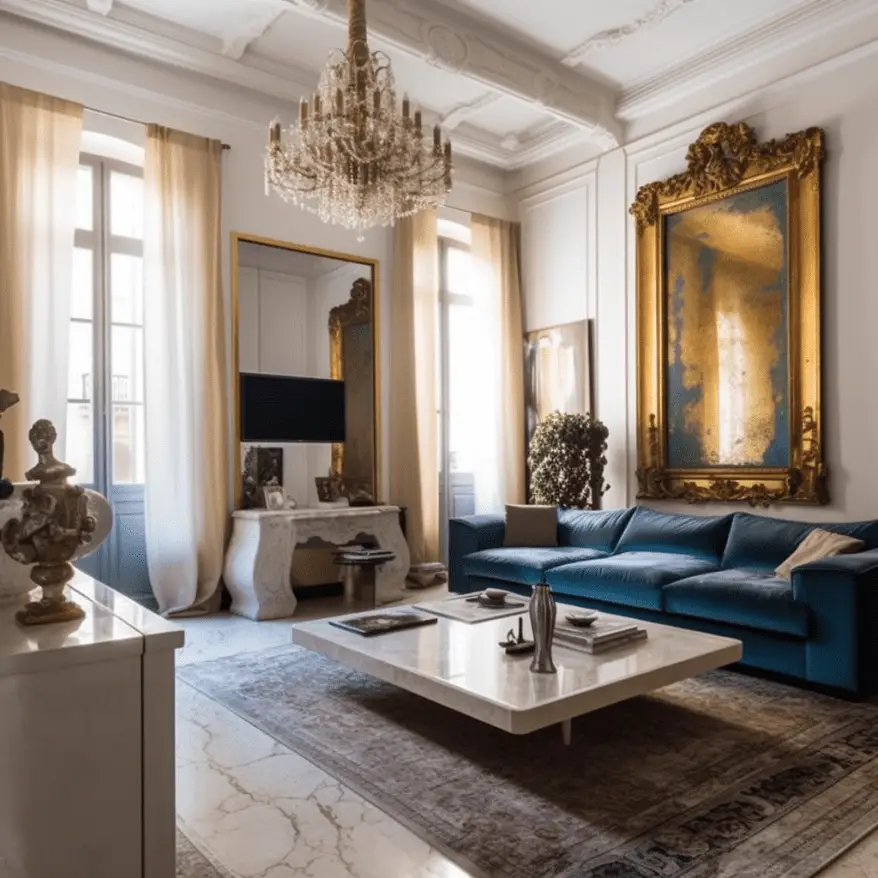
The living room is often the heart of the home, making it the perfect space to showcase Italian design. To create an inviting atmosphere:
- Choose comfortable seating options, such as plush sofas and armchairs, upholstered in luxurious fabrics like velvet or silk.
- Incorporate statement pieces like a carved wooden coffee table or a grand chandelier to add a touch of opulence.
- Use warm, earthy tones for your color palette, and add pops of color with decorative cushions or artwork.
- Display Italian-inspired art, such as Renaissance paintings or sculptures, to bring a sense of history and culture to the space.
Kitchen
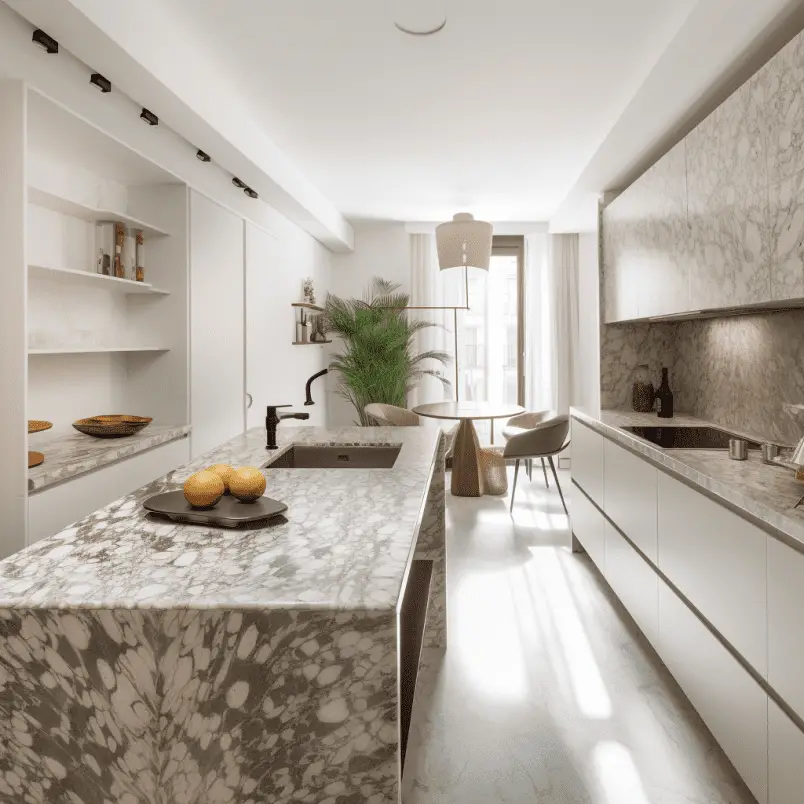
Italian design in the kitchen emphasizes both beauty and functionality:
- Opt for high-quality materials like marble countertops, terracotta/terrazzo flooring, or wrought iron accents to infuse the space with Italian charm.
- Choose cabinetry that showcases exceptional craftsmanship, such as those with intricate carvings or decorative moldings.
- Integrate modern appliances with classic design elements to create a seamless blend of old and new.
- Accessorize with Italian ceramics, such as decorative plates or bowls, to add a touch of character and color.
Bedroom

Create a serene and luxurious retreat in your bedroom with Italian design:
- Invest in a classic, ornately carved bed frame to serve as the focal point of the room.
- Use rich, sumptuous fabrics like silk or velvet for bedding, curtains, and upholstery.
- Incorporate soft, romantic lighting with table lamps or a chandelier to create a warm ambiance.
- Display Italian-inspired artwork or accessories, such as an antique mirror or decorative vases, to add visual interest and sophistication.
Bathroom
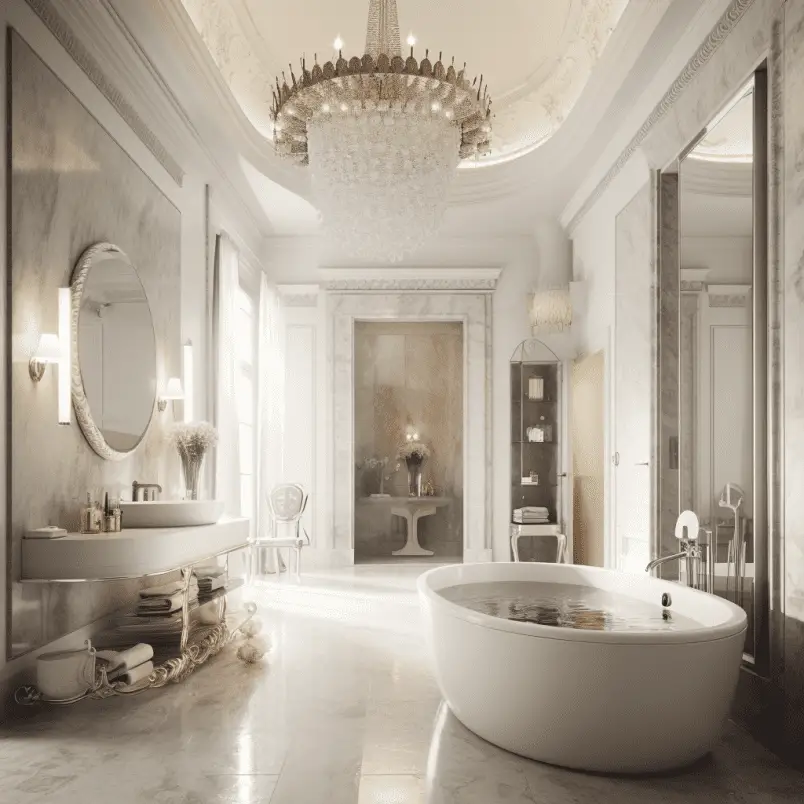
Transform your bathroom into a spa-like oasis with Italian design elements:
- Choose luxurious materials like marble or travertine for countertops, flooring, and wall tiles.
- Opt for a freestanding bathtub or a walk-in shower with a glass enclosure to create a sense of openness and grandeur.
- Use elegant fixtures in finishes like brushed gold, chrome, or oil-rubbed bronze to add a touch of refinement.
- Incorporate greenery with potted plants or fresh flowers to bring a sense of nature and tranquility to the space.
Outdoor Spaces

Don’t forget to extend Italian design principles to your outdoor living areas:
- Create an inviting seating area with comfortable, stylish furniture that showcases Italian craftsmanship.
- Use materials like terracotta or wrought iron for outdoor accents and accessories.
- Incorporate a water feature, such as a fountain or a small pond, to add a sense of serenity and beauty.
- Design an outdoor kitchen or dining area that reflects Italian love for al fresco meals and gatherings.
Pros and Cons of Italian Interior Design: A Comprehensive Look
Italian interior design is known for its elegance, sophistication, and attention to detail. However, as with any design style, it comes with its own set of advantages and disadvantages. Let’s explore the pros and cons of Italian interior design to help you determine if it’s the right choice for your home.
Pros of Italian Interior Design
- Elegance and Sophistication: Italian design is synonymous with refined taste and timeless elegance. It often features high-quality materials, exquisite craftsmanship, and intricate details, which can add a touch of luxury to any space.
- Rich Color Palette: Italian interior design is known for its warm and rich color palette, which includes earthy tones, deep reds, and vibrant blues. These colors can create an inviting and cozy atmosphere in your home.
- Time-Honored Craftsmanship: Italian design places great emphasis on craftsmanship and the use of traditional techniques. This can result in high-quality, durable furniture and accessories that stand the test of time.
- Unique and Authentic: Incorporating Italian interior design elements into your home can give it a unique and authentic feel, setting it apart from other design styles.
- Blend of Old and New: Italian design often combines classical elements with modern touches, creating a harmonious blend of old and new. This can give your space a sense of history while still feeling contemporary and fresh.
Cons of Italian Interior Design
- Cost: One of the main drawbacks of Italian interior design is the cost. High-quality materials, craftsmanship, and imported pieces can come with a hefty price tag, making it less accessible for those on a tight budget.
- Availability: Depending on where you live, it may be challenging to find authentic Italian furniture and accessories. This can make it difficult to achieve a truly Italian-inspired design in your home.
- Not Ideal for Minimalists: Italian design is known for its elaborate details, ornate decoration, and rich textures. This can be overwhelming for those who prefer a more minimalist approach to interior design.
- Potential for Overcrowding: The emphasis on decorative elements and accessories in Italian design can lead to overcrowded spaces if not executed thoughtfully. It’s essential to strike a balance between elegance and functionality to avoid creating a cluttered environment.
- Maintenance: Italian interior design often involves delicate materials and intricate details that may require additional care and maintenance, making it less practical for busy households or those with young children.
Conclusion
Italian interior design is the epitome of elegance, sophistication, and timeless beauty. By incorporating its key elements into your home, you can create a space that feels both luxurious and inviting. From embracing architectural details and investing in classic furniture to selecting rich materials and displaying beautiful art, every aspect of Italian design comes together to create a truly stunning and unique aesthetic.
As you embark on your Italian design journey, remember to stay true to your personal style and preferences. After all, the essence of Italian design lies in the perfect blend of classic elements and modern sensibilities. By doing so, you’ll create a space that not only pays homage to Italy’s rich design heritage but also reflects your own unique taste.
Frequently Asked Questions
What is the main difference between Italian and French interior design styles?
While both styles emphasize elegance and sophistication, Italian design tends to be more opulent and grand, while French design often leans towards a more rustic and romantic aesthetic. Italian interiors typically feature more luxurious materials and architectural details, whereas French spaces often incorporate a softer color palette and vintage-inspired furniture.
Can I mix Italian design with other styles in my home?
Absolutely! Italian design can be easily blended with other styles, such as modern, minimalist, or even industrial. The key is to find a balance between the different design elements and maintain a cohesive overall look.
Where can I find authentic Italian furniture and accessories?
You can find Italian furniture and accessories at specialized retailers, antique stores, or online platforms that focus on European design. Additionally, many high-end furniture brands offer Italian-inspired collections that showcase the country’s exceptional craftsmanship and design.
How can I add a touch of Italian design to my home without undergoing a complete renovation?
You can introduce Italian design elements through smaller changes, such as incorporating decorative accessories, adding Italian-inspired artwork, or updating your color palette with warm, earthy tones. These subtle additions can help infuse your space with Italian charm without the need for a major renovation.
Is Italian interior design suitable for small spaces?
Yes, Italian design can be adapted to suit small spaces. The key is to focus on incorporating high-quality materials, using a well-balanced color palette, and selecting furniture that is both functional and stylish. By doing so, you can create a sense of luxury and elegance even in a limited space.

